Here you’ll find a comprehensive guide and tips on how to freeze different kinds of food, so you can easily pack them for your bento box for a stress-free morning!
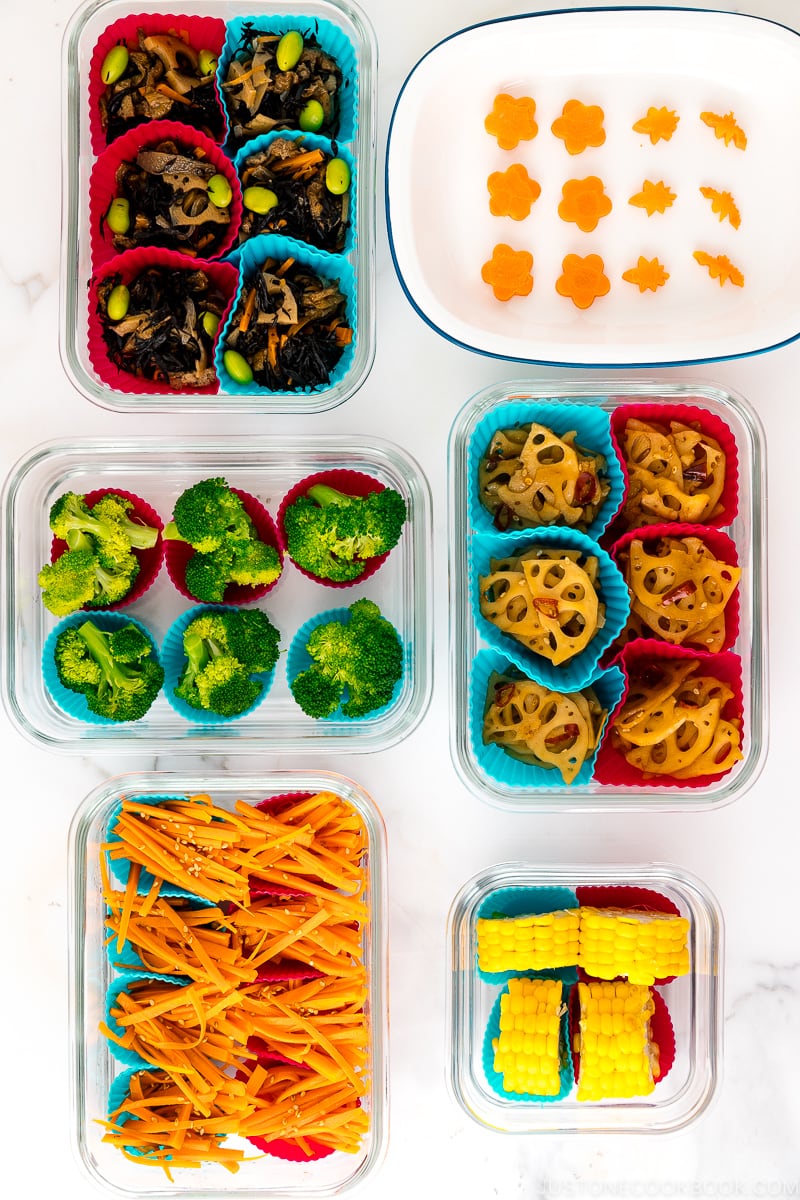
This is the basic guide to storing freezer-friendly dishes for your bento lunch box. Once you learn how to properly freeze pre-cooked meals, you can save so much time to make bento in the morning!
Table of Contents
Helpful Kitchen Tools
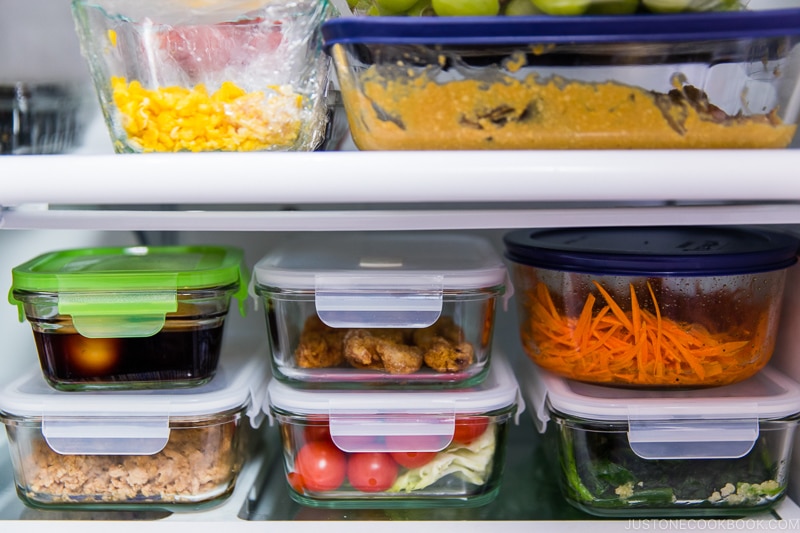
To keep everything organized, I find these containers and silicon cups extremely helpful.
- Glass containers for storing rice
- Glass containers for meal prep
- Silicone cups (I have both mini and regular sizes)
How To Freeze Cooked Rice
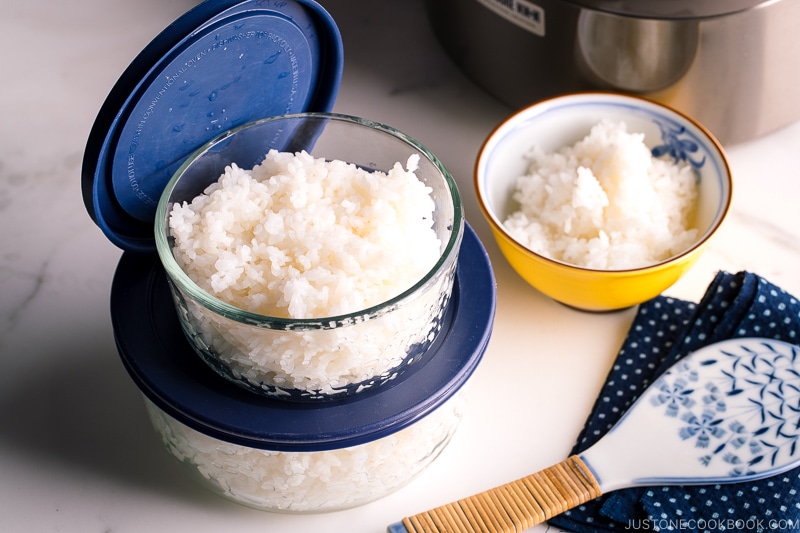
You don’t have to cook rice just to make bento every morning. My go-to method is to use frozen rice for bento and I only make rice when I’m out of the frozen rice (I set timer before I go to sleep). Japanese people always keep the rice in the freezer and not in the fridge.
It’s so much easier to store extra steamed rice in the freezer and use it whenever we need it. Even if we need rice for the following day, freezing rice is the best way. Rice gets hard and dry in the fridge, but not if you store it in the freezer. I make extra and always keep a few containers of different portions of steamed rice in the freezer.
To make it easy, I have different-sized containers for a bento portion, 1 serving of rice, and 2 servings of rice. It’s easy to take it out and pop it in the microwave to defrost the frozen rice in the morning. Once the rice is warmed through, pack it in bento boxes or make rice balls (onigiri).
👉🏼 Read more about How to Store Cooked Rice or see the freezing instructions below.
How To Freeze Pan-Fried Food
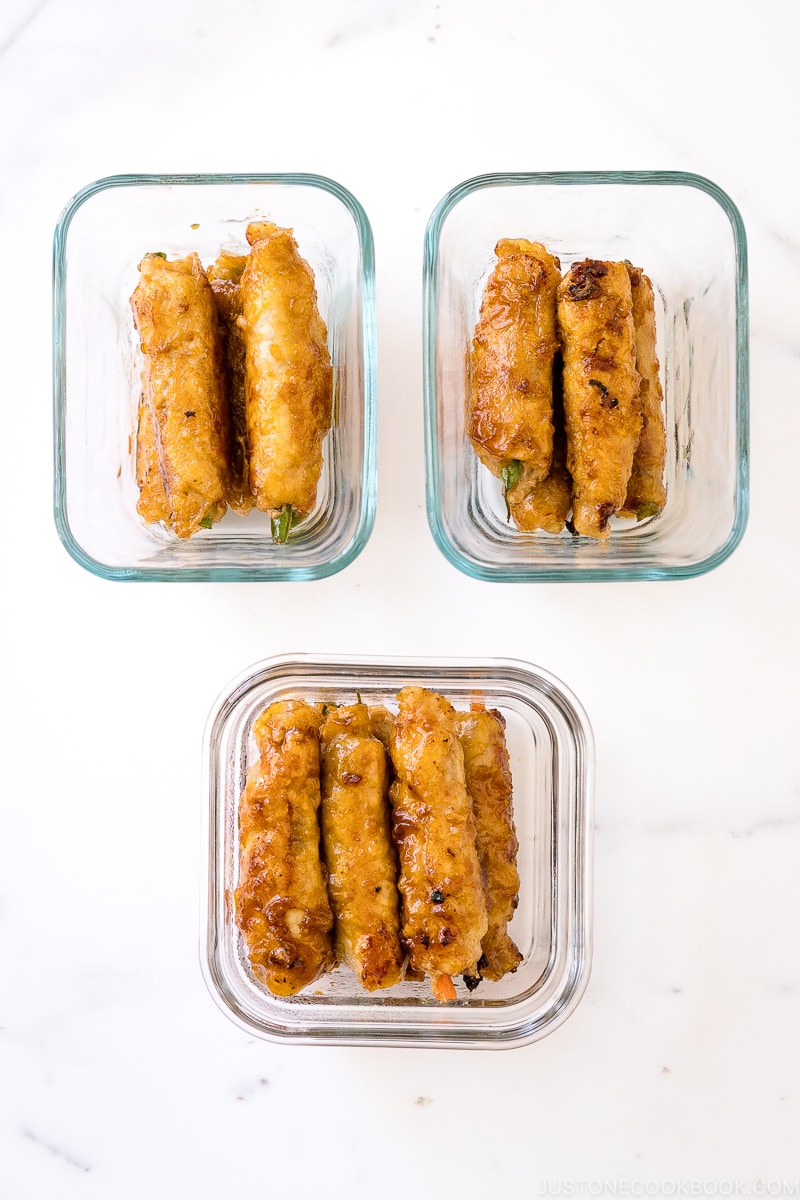
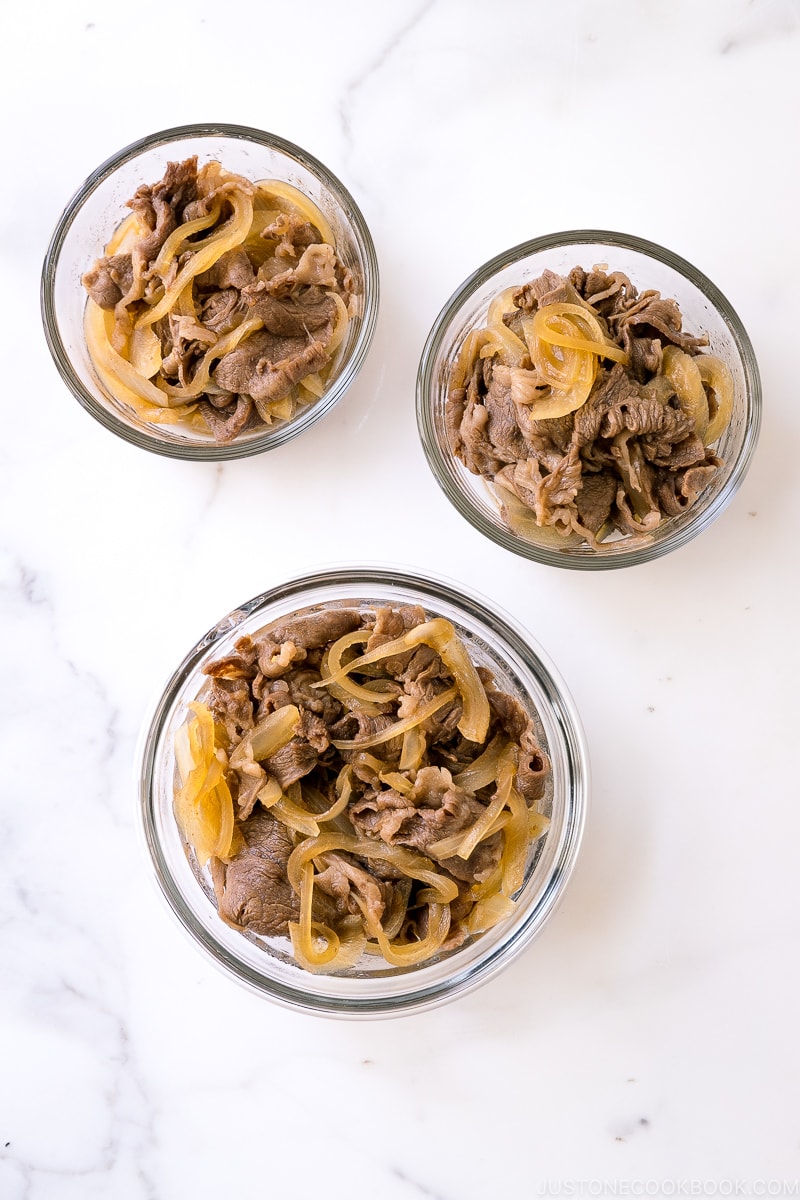
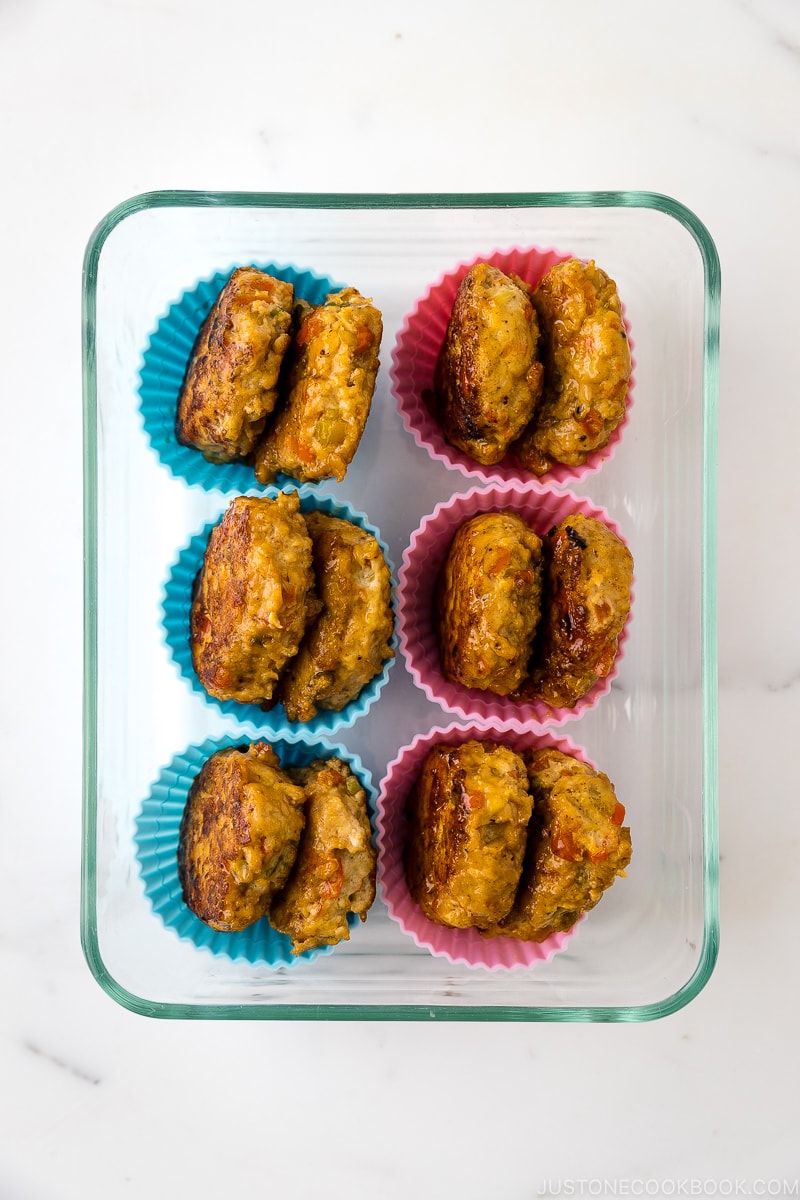
When packing for bento lunch boxes, I rarely make the main dish from scratch in the morning. Instead, I search for leftover meals that I packed and saved in the freezer previously. It’s a similar concept to meal prep, but all dishes are kept in the freezer.
When you have leftover from dinner and don’t need to pack for bento next day, freeze the leftover dishes right away. I recommend packing in individual portions, 1-2 servings in my case. This way, I can quickly defrost the exact portions I need for lunch boxes.
Depending on the type of pan-fried or simmered foods, utilize silicone cups so you can take out the exact portions you need.
Use airtight glass containers so you can microwave them. When you reheat, remove the plastic cover and place a sheet of paper towel on top to avoid oil splatter and maintain the moisture in the food.
👉🏼 See the freezing instructions below.
How To Freeze Deep-Fried Food
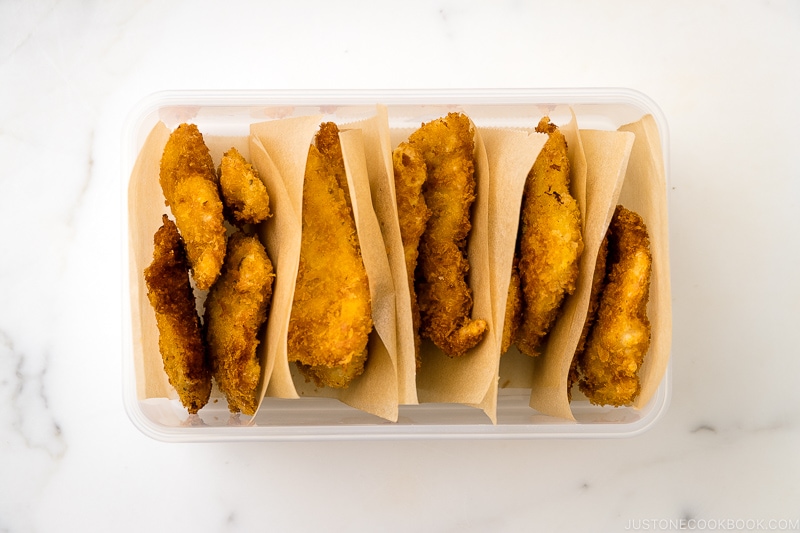
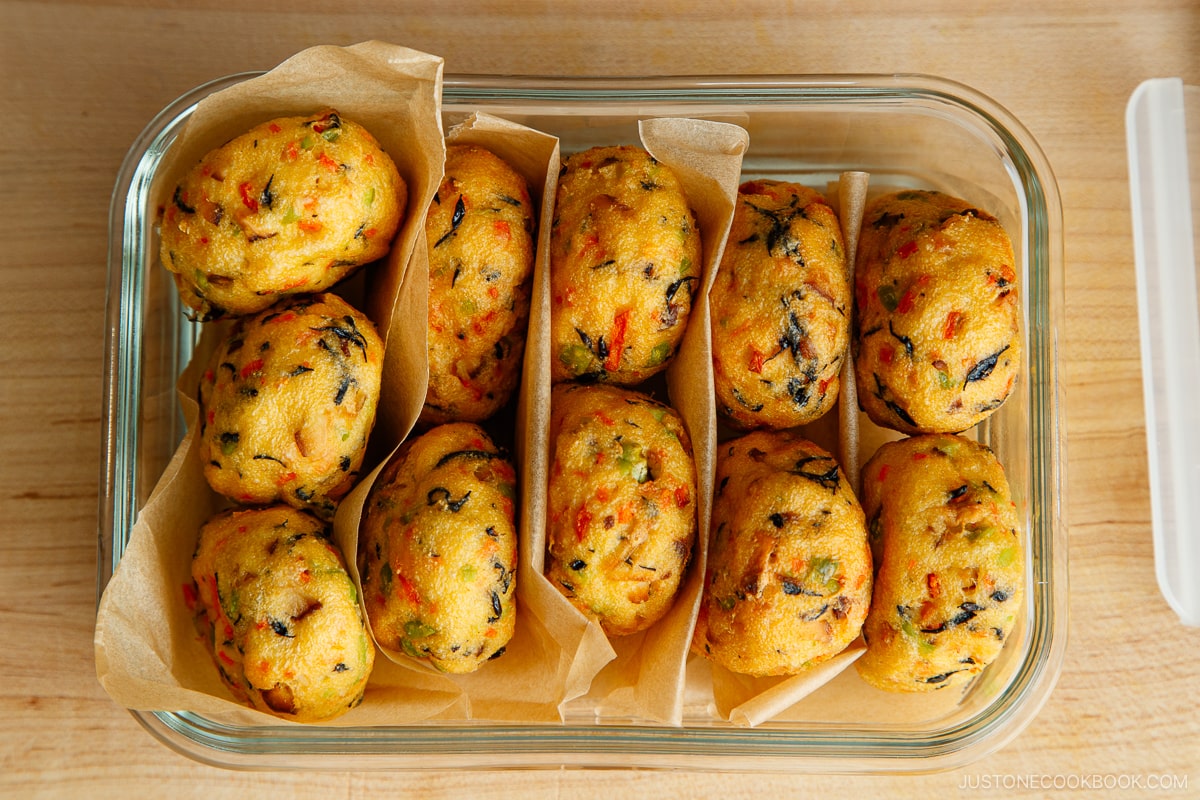
I always have leftovers whenever I deep fry food. It’s so much easier to make a big batch and enjoy the fried foods another day without having to deep fry again.
If you are going to store all the fried foods in one container and will likely not using it at once, use parchment paper to divide the pieces. This way, you can take out the pieces you need and reheat them. Without the parchment divider, food will likely to get stuck while freezing.
To reheat, I use a toaster oven or oven at 375°F (190°C) until warm. Don’t microwave as the crust gets soft and lose the “deep-fried” texture.
👉🏼 See the freezing instructions below.
How To Freeze Blanched Vegetables
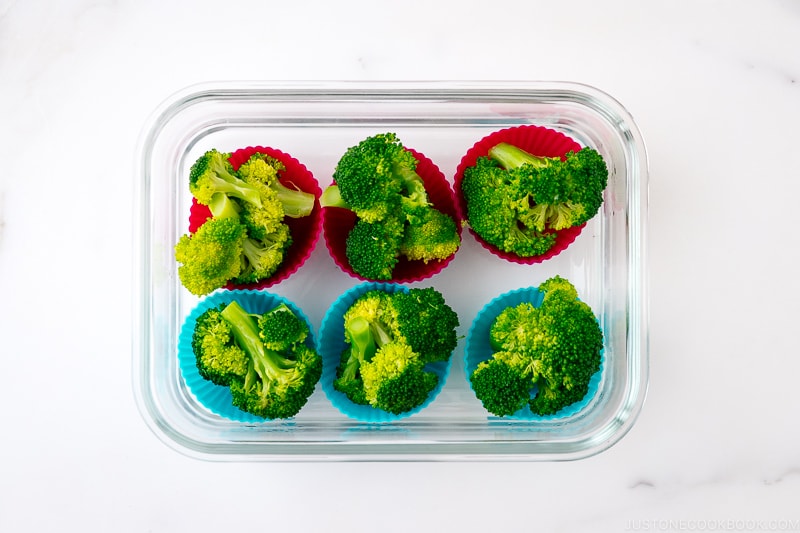
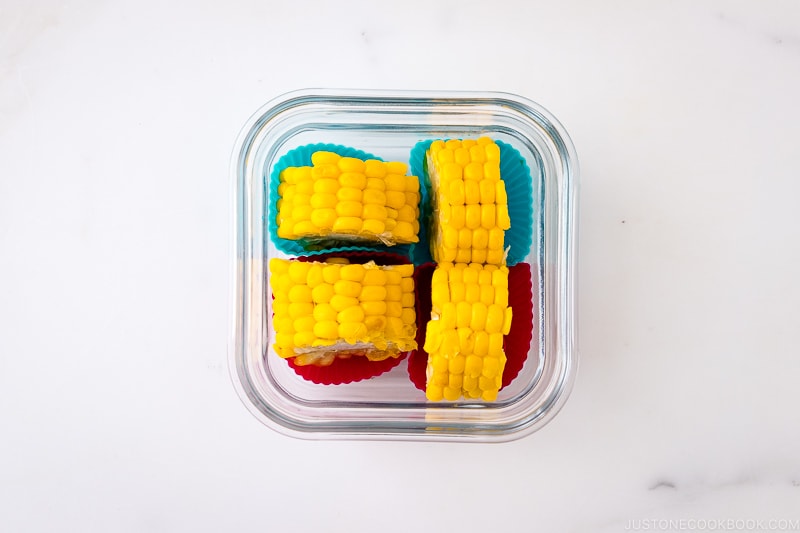
When packing bento, blanched vegetables come in handy for a few reasons.
- Vegetables add colors to the lunch box.
- You can cut down on additional cooking time (stir-frying, for example) if the vegetables are pre-cooked already.
- You can add the blanched vegetables directly into the lunch box with salad dressing or homemade sauce.
I always make sure I have a few kinds of blanched vegetables available in the freezer. It helps me prep bento lunches fast!
👉🏼 See the freezing instructions below.
How To Freeze Vegetable Dishes
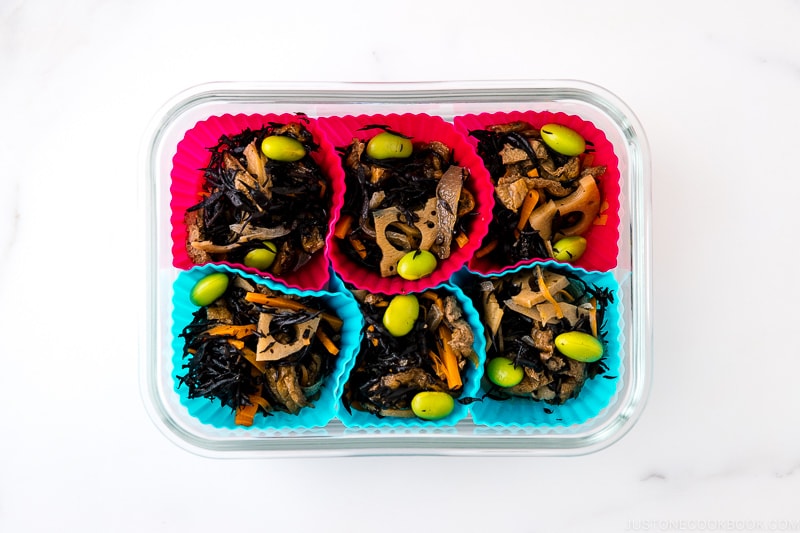
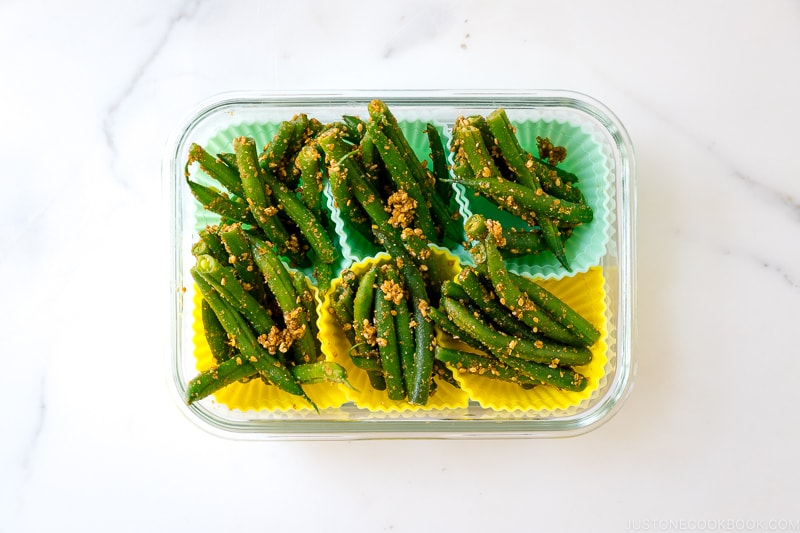
Make a big batch of vegetable side dishes and store in the freezer. In Japanese cuisine, we have a lot of dishes that are freezer-friendly!
- Hijiki Salad
- Green Bean Gomaae
- Spinach with Sesame Sauce
- Chrysanthemum Greens Salad
- Spinach with Sesame Miso Sauce
- Easy Carrot Salad (Carottes Rapees)
- Spinach Namul and Bean Sprout Namul
👉🏼 See the freezing instructions below.
How To Freeze Tamagoyaki
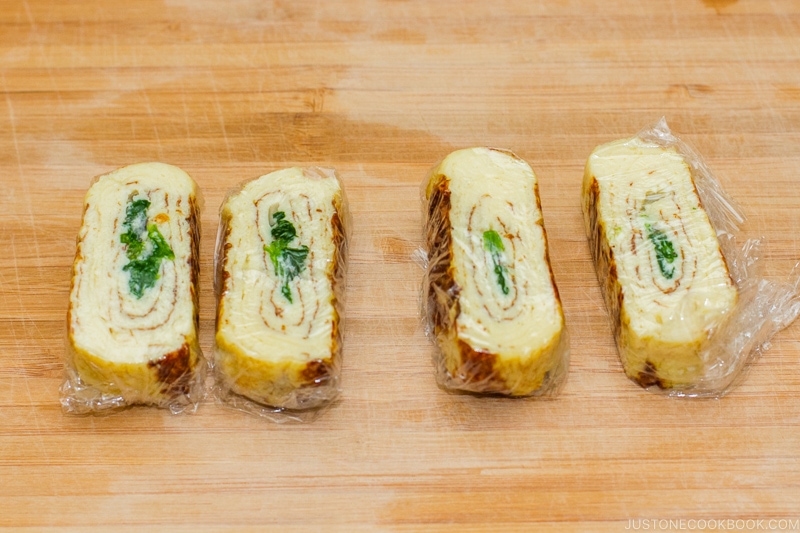
A bento classic, Tamagoyaki, can be frozen, too! I usually keep extra in the freezer so I can pack it in the bento box or enjoy it as a snack or as a part of breakfast.
👉🏼 See the freezing instructions below.
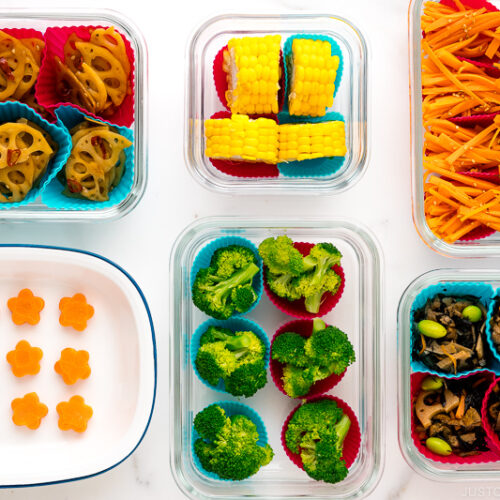
How To Freeze Food For Bento
Materials
- leftovers or meal prep food
Instructions
How To Freeze Cooked Rice
- (Ideally, as soon as the rice is done cooking) Pack the cooked rice with steam and cover the lid immediately to seal in the steam and moisture. Let cool completely on the kitchen counter. You do not want to spoil your food in the freezer with your hot/warm rice. Store in the freezer for up to 1 month. Reheat by microwaving.

How To Freeze Pan-Fried Food
- Put each portion of the cooked food in silicone cups or in separate small containers. Let cool completely, keeping the container lid(s) open, on the kitchen counter. Store in the freezer for up to 3 weeks. Reheat thoroughly by microwaving, pan-frying, or baking at 350ºF (180ºC).

How To Freeze Deep-Fried Food
- After deep frying, let cool completely. Put them in a large airtight container, separating each portion with parchment paper. Store in the freezer for up to 3 weeks. Reheat thoroughly (without thawing) by baking at 375ºF (190ºC) in the oven or the toaster oven till heated through and crispy.

How To Freeze Blanched Vegetables
- Blanch vegetables (broccoli, asparagus, green beans, bell peppers, zucchini, carrots, corn etc) till tender but crisp (don’t overcook!). Drain well or squeeze water out. Let cool completely. Pat dry with a paper towel to make sure all the moisture is removed. Put each portion in silicone cups and put them in a larger container. Store in the freezer for up to 2-3 weeks. You can pack directly into your bento box (no reheating!) or thaw overnight in the fridge (and serve with a salad dressing), or cook/stir-fry in the morning while frozen.

How To Freeze Vegetable Dishes
- Drain, if there is any liquid, and put each portion in silicone cups and place them in a large container. Let cool completely. Store in the freezer for up to 2-3 weeks. Pack directly into your bento box (no reheating!) or thaw overnight in the fridge.

How To Freeze Tamagoyaki
- Let cool completely. Place the tamagoyaki slices in a container, keeping them separated so it’s easy to take one out. Or you can wrap each slice of tamagoyaki in plastic wrap and put it in a freezer bag. Keep in the freezer for up to 2 weeks. Pack directly into your bento box (no reheating!).

Wish to learn more about Japanese cooking? Sign up for our free newsletter to receive cooking tips & recipe updates! And stay in touch with me on Facebook, Pinterest, YouTube, and Instagram.
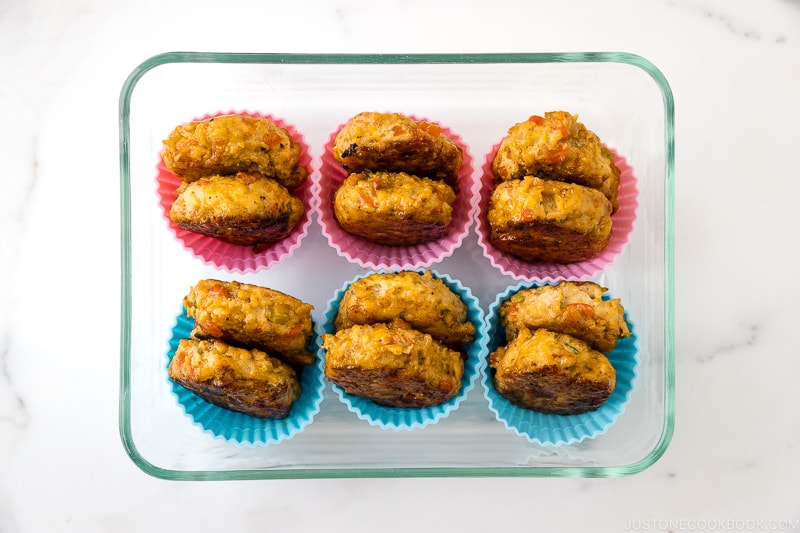










Hi Nami, thank you for responding to my question. Yes, I fish for tuna when given the chance. My problem is how to freeze fresh tuna when I have a lot left after eating and giving away some to friends. My last effort turned out extremely powerful fishy smelling, eveven after using my food saver. Can you give me a clue?
Hi Ken! I see… I’m not an expert in this, but what I know is that it’s important to breed the fish. Maybe talk to the fisherman or google might have some good articles. Sorry I wish I could help more…
One article said: To freeze fresh tuna, prepare a solution of 1 tablespoon ascorbic acid crystals to 1 quart of water or 1/4 cup salt dissolved in 1 quart of water. Dip the fish into the solution to firm it up. Seal in plastic wrap and then in a zip-top bag.
Better yet, freeze it in an ice block by putting into a zip-top bag and covering with water. Squeeze out all the air and seal the bag. Freeze up to three months.
I would like to know how to freeze. Tuna.
Hi Ken! Hmmm you mean you fish tuna and how to freeze it?
for fried food, does it have to be frozen for three weeks or no??
Hi Niko! No, it’s “up to” 3 weeks, so you can keep it for 3 weeks if you want to. 🙂
This is super duper helpful. Thank you SO much!!
Thank you Jen! 🙂
Thank you! I just discovered this site and will be coming back! Thank you for making the prep and all seem so doable 🙂 Arigatou gozaimashita!
Hi Kelly! So happy that you found my site. Thank you for visiting! I hope you find some recipes that you enjoy. 🙂
I tried to freeze your crispy baked salmon. But after I reheated them using oven toaster (I thawed them first), they tend to be a bit dry on the inside (the salmon). Any advice on how I should do it? Thanks ????
Hi Leony! I usually don’t defrost panko fried foods and I put directly into toaster oven. Once it’s thawed, the panko coating gets soggy. Maybe the moisture also left when you defrosted? Hope this helps!
Hi,
can you teach how to freeze noodle / pasta?
Hi Lynette! Cook normally, drain, pack in an air-tight container, close the lid, let cool on the kitchen counter, and then to freeze. 🙂
can i freeze Japanese curry?
Sure! I do that all the time! However, potato’s texture will change after frozen, so I usually remove potato (or purposely eat them so no leftover potatoes) and freeze the rest. 🙂
Hey, Thanks for all of your advice! You do a fantastic job of explaining things that others do not! I love making bento for myself and enjoy the recipes and creation but I have a question that I can’t find an answer too.
When I make Onigiri do I cool it down to room temp on a plate before putting it in the bento and closing the lid? If so does this make it dry out? and when you say leave things to cool down before closing the lid do you mean placing warm food into the bento and letting it cool inside? Doesnt that leave moisture under the food ?
Please help : )
Hi Kyle! Thank you so much for your kind feedback! Here are my answers:
1) If you are making onigiri with very hot rice (like just finished cooking), I’d definitely keep it outside on the plate until it cools down. Onigiri will dry out if you leave it for a long time, but not so much for 10 minutes or so (in fact, if I serve onigiri for a meal time, I still consider onigiri is not dry during the whole meal time). The surface of rice gets a bit dry, but it’s not too bad. Oh but I use Japanese rice, which has more moisture than other kinds of rice.
2) If the rice is not super hot, I may add it into the bento box (only when other bento menus are all warm) and keep it open until cool down.
3) In general, if you add warm food into bento box, it takes longer time to cool down because it’s surrounded by the other warm food and wall of bento box… It’s faster if you keep the food outside first. If I’m still doing something in the kitchen, I usually put all the food in silicon cups and leave them out until cool down, then pack all them into a bento box. However, when I have to leave the kitchen, I would finish packing (still warm) food in the bento, and let it cool. But all I need to do is to close the lid before we leave the house. So it works either way, but you want to cool your bento as much as possible so there will be no condensation.
Hope that helps?! 🙂
Thank you soo much, I’ve been wondering how to freeze food for bento for a while now, and you covered everything really clearly! ☺ Maya
Hi Maya! I’m so glad to hear that! Thank you very much for your kind feedback! xo 🙂
Hi Nami,
Thank you for the post–this is super helpful. I have a question regarding freezing vegetables that have sauce. Would you wrap it in individual servings with the sauce, or should the sauce even be frozen at all?
Thank you!
Hi Yuna!
I’m so happy to hear you enjoyed this post! What kind of sauce you are talking about? Is it thinly water-based sauce, or creamy milk/oil base sauce?
Normally, the flavor gets stronger/saltier when you freeze with seasonings. The texture also gets more wilted too from salt content. I would personally freeze the sauce and vegetables separately and combine together when I put the salad. If it’s easy to make the sauce, I might make it ahead of time and combine together to toss. Hope this helps! 🙂
Hi Nami,
I enjoy reading your tips on how to make bento. May I know do you defrost the frozen pan fried food before reheating?
Thanks!
Dianne
Hi Dianne! Thank you for reading my post. 🙂 If it’s pan fried food, I’d defrost it in the fridge overnight, and I reheat it by a microwave or cooking in the pan in the morning. It depends. If the food is thick and it looks like a long time to reheat, I’d definitely defrost ahead of time in the fridge before reheating. But if the food looks like it will heat up quickly, then I sometimes reheat the food directly from the freezer. Hope this helps! 🙂
Thanks Nami!
Hi Nami
I am totally new to making Bentos.
Would you be able to give us an idea on how early you wake up to prepare the bento?
Could you do a post on this? Pls also do share with us how you use the insulated bag etc.
Many thanks!
Hi BK! I usually spend maximum 20 minutes for bento making besides making breakfast. I usually re-heat leftover food and let the food cool down takes up the most of bento making time.
Please refer to my bento post and start reading here: https://www.justonecookbook.com/recipes/how-to-make-bento/
Hi Nami,
Thanks for your so your clear explanation on how to store and prepare bento food. May I know
1) You mentioned to freeze the Tamogoyaki and vegetables and put in bento box without reheating. Will the vege or egg be cold when they eat the food during lunch time?
I’m always worried about kids eating over-night / leftover food or even store few weeks, but with your recommendations and tips, I felt much more safer and at ease. Thanks so much.
Hi Shirley! It should be cool or room temp depending on how you store the bento until lunch time. If you put it in thermal lunch box with ice pack, I think it will stay cool. Otherwise, by lunch time, it should be at room temp. How do your kids bring lunch to school? I recommend to put bento box in insulated bag with ice. If it’s made fresh on previous night (for dinner), I am pretty comfortable to put leftover dinner in lunch box, keep in refrigerator (after cool down), and put the bento box straight to lunch bag. However, if the food was a few days old etc, I will usually avoid putting in lunch box (but I would eat it at home after reheating). Since school doesn’t have microwave or stove, I don’t feel comfortable to pack in lunch box. I hope this helps. 🙂
Hi Nami,
I know this is an old post, but I’m learning how to make bento box for my son. I plan to use the leftover dinner from previous night. Do you mean that I can just pack the leftover food straight into the bento box, refrigerate the food inside the lunch box, and then just put the lunch box to the lunch bag, without reheating? I read from your other post, about food safety, that you recommend to re-heat the food before packing for that day. Please advise. I am a bit confused here 🙂
Hi Dewi! In Japan where lunch box is eaten at room temperature, it’s commonly prepared in the morning. For the food safety reason, food is usually re-heated (to kill any bacteria that you don’t see), and let it cool down completely before packed into the lunch box. Japanese moms usually wake up at super early before 6 am to pack kids’ lunch… but it’s not common outside of Japan to do that. So as long as the food prepared previous night is fresh (not old food), I think it’s okay to pack the leftover dinner in the lunch box, keep in the fridge, and continue to chill in the lunch box with ice packs until lunch time. Bacterias grow at warmer temperature, so that way, you can keep it safer. When I was growing up, there was no ice packs – even when you buy lunch box in Japan, it’s kept at room temperature. No ice packs (that will ruin the lunch in a way). So food is prepared in the morning and packed properly (after cool down). Hope this makes sense?
You explain the basics of bulk cooking, storing and reheating extremely well!
Thank you!!
Thank you! 🙂